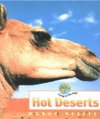Improving the Camel Additional Information
The National Research Centre on Camel, Bikaner has a Web site www.icar.org.in/nrccm/home.html (Indian Council of Agricultural Research).
You can learn more about the importance of camels at www.sfusd.k12.ca.us/schwww/sch618/Animals/Animals.html (Horace Mann Middle School, San Francisco), www.planet-pets.com/plntcaml.htm (Planet Pets), and camelfarm.com/camel_information.html (Calamunnda Camel Farm, Australia).
Additional information about wild camels can be found at www.wildcamels.com/ Wild Camel Protection Foundation).
Books recommended by SearchIt!Science:
 |
Hot Deserts— Wendy PfefferPublished by Benchmark Books/Marshall Cavendish, 2003.
It must be hard to survive in a desert. During the day, the temperature can reach up to 165 degrees Fahrenheit (74 degrees Celsius). At night, the temperature might only be 40 degrees Fahrenheit (4 degrees Celsius). However, many animals and plants thrive in the harsh environment. In this book, learn how animals have adapted to the scorching heat and drought. For example, see how the Arabian camel’s thick hair insulates its body from the sun. Complete with full-color photographs of many desert plants and animals and a suggested reading list, this book will introduce you to the many treasures that the desert climate has to offer. |
Power Words
breed 1. To reproduce by giving birth or hatching. Mosquitoes breed in water. Seals breed on land. 2. To raise animals or plants, often to produce new or better kinds.
Copyright © 2002, 2003 Houghton-Mifflin Company. All rights reserved. Used with permission.
